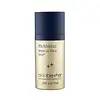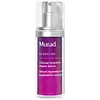What's inside
What's inside
 Key Ingredients
Key Ingredients

 Benefits
Benefits

 Concerns
Concerns

 Ingredients Side-by-side
Ingredients Side-by-side

Water
Skin ConditioningButylene Glycol
HumectantPropanediol
SolventEthylhexyl Olivate
Skin ConditioningCetearyl Alcohol
EmollientChlorogenic Acids
AntioxidantNiacinamide
SmoothingLauryl Lactate
EmollientDimethyl Isosorbide
SolventPyrroloquinoline Quinone Allyl Ester
AntioxidantHydrolyzed Sodium Hyaluronate
Skin ConditioningGlycyrrhiza Glabra Root Extract
BleachingTetrahexyldecyl Ascorbate
AntioxidantErgothioneine
AntioxidantBenzylidene Dimethoxydimethylindanone
Skin ProtectingArabidopsis Thaliana Extract
AntioxidantCarnosine
Skin ConditioningCamellia Sinensis Leaf Extract
AntimicrobialVitis Vinifera Seed Extract
AntimicrobialTheobroma Cacao Seed Extract
AntioxidantCurcuma Longa Root Extract
MaskingOlea Europaea Fruit Extract
BleachingEuterpe Oleracea Fruit Extract
Trifluoroacetyl Tripeptide-2
Skin ConditioningBuddleja Officinalis Flower Extract
UV FilterCoffea Arabica Leaf Cell Extract
AntioxidantCrocus Sativus Leaf Cell Culture Extract
Skin ProtectingSuperoxide Dismutase
AntioxidantUbiquinone
AntioxidantPlankton Extract
Skin ConditioningMicrococcus Lysate
Skin ConditioningArginine
MaskingZingiber Officinale Root Extract
MaskingCeramide NP
Skin ConditioningCeramide AP
Skin ConditioningCeramide EOP
Skin ConditioningLinoleic Acid
CleansingLinolenic Acid
CleansingSea Whip Extract
Skin ConditioningBisabolol
MaskingTocopherol
AntioxidantTocopheryl Acetate
AntioxidantCholesterol
EmollientPhytosphingosine
Skin ConditioningJojoba Esters
EmollientSodium PCA
HumectantPentylene Glycol
Skin ConditioningMethyl Gluceth-20
HumectantGlycerin
HumectantHelianthus Annuus Seed Wax
Skin ConditioningAcacia Decurrens Flower Wax
EmollientLecithin
EmollientSodium Lauroyl Lactylate
EmulsifyingDicetyl Phosphate
EmulsifyingPropanediol Dicaprylate/Caprate
EmollientPolyglycerin-3
HumectantCeteth-20 Phosphate
CleansingDiisostearyl Malate
EmollientXanthan Gum
EmulsifyingSteareth-2
EmulsifyingAcacia Senegal Gum
MaskingPentaerythrityl Tetra-Di-T-Butyl Hydroxyhydrocinnamate
AntioxidantCarbomer
Emulsion StabilisingAcrylates/C10-30 Alkyl Acrylate Crosspolymer
Emulsion StabilisingDextran
Ricinoleth-40
CleansingSodium Hydroxide
BufferingCitric Acid
BufferingSodium Phytate
Ethylhexylglycerin
Skin ConditioningPhenoxyethanol
PreservativeWater, Butylene Glycol, Propanediol, Ethylhexyl Olivate, Cetearyl Alcohol, Chlorogenic Acids, Niacinamide, Lauryl Lactate, Dimethyl Isosorbide, Pyrroloquinoline Quinone Allyl Ester, Hydrolyzed Sodium Hyaluronate, Glycyrrhiza Glabra Root Extract, Tetrahexyldecyl Ascorbate, Ergothioneine, Benzylidene Dimethoxydimethylindanone, Arabidopsis Thaliana Extract, Carnosine, Camellia Sinensis Leaf Extract, Vitis Vinifera Seed Extract, Theobroma Cacao Seed Extract, Curcuma Longa Root Extract, Olea Europaea Fruit Extract, Euterpe Oleracea Fruit Extract, Trifluoroacetyl Tripeptide-2, Buddleja Officinalis Flower Extract, Coffea Arabica Leaf Cell Extract, Crocus Sativus Leaf Cell Culture Extract, Superoxide Dismutase, Ubiquinone, Plankton Extract, Micrococcus Lysate, Arginine, Zingiber Officinale Root Extract, Ceramide NP, Ceramide AP, Ceramide EOP, Linoleic Acid, Linolenic Acid, Sea Whip Extract, Bisabolol, Tocopherol, Tocopheryl Acetate, Cholesterol, Phytosphingosine, Jojoba Esters, Sodium PCA, Pentylene Glycol, Methyl Gluceth-20, Glycerin, Helianthus Annuus Seed Wax, Acacia Decurrens Flower Wax, Lecithin, Sodium Lauroyl Lactylate, Dicetyl Phosphate, Propanediol Dicaprylate/Caprate, Polyglycerin-3, Ceteth-20 Phosphate, Diisostearyl Malate, Xanthan Gum, Steareth-2, Acacia Senegal Gum, Pentaerythrityl Tetra-Di-T-Butyl Hydroxyhydrocinnamate, Carbomer, Acrylates/C10-30 Alkyl Acrylate Crosspolymer, Dextran, Ricinoleth-40, Sodium Hydroxide, Citric Acid, Sodium Phytate, Ethylhexylglycerin, Phenoxyethanol
Water
Skin ConditioningGlycerin
HumectantPentylene Glycol
Skin ConditioningVaccinium Myrtillus Seed Oil
Skin ConditioningC14-22 Alcohols
Emulsion StabilisingPersea Gratissima Oil
Skin ConditioningLactobacillus Ferment
Skin ConditioningSalix Alba Extract
Skin ConditioningZanthoxylum Bungeanum Fruit Extract
Skin ConditioningSodium Hyaluronate Crosspolymer
HumectantHexapeptide-9
Skin ConditioningUrea
BufferingYeast Amino Acids
HumectantTrehalose
HumectantInositol
HumectantTaurine
BufferingBetaine
HumectantHydroxyacetophenone
AntioxidantTocopherol
AntioxidantOleyl Alcohol
EmollientEthylhexylglycerin
Skin ConditioningPullulan
C12-20 Alkyl Glucoside
EmulsifyingSclerotium Gum
Emulsion StabilisingLysolecithin
EmulsifyingXanthan Gum
EmulsifyingSilica
AbrasiveGlucose
HumectantLeuconostoc/Radish Root Ferment Filtrate
AntimicrobialTetrasodium Glutamate Diacetate
Sodium Hydroxide
BufferingChlorphenesin
AntimicrobialLimonene
PerfumingLinalool
PerfumingParfum
MaskingWater, Glycerin, Pentylene Glycol, Vaccinium Myrtillus Seed Oil, C14-22 Alcohols, Persea Gratissima Oil, Lactobacillus Ferment, Salix Alba Extract, Zanthoxylum Bungeanum Fruit Extract, Sodium Hyaluronate Crosspolymer, Hexapeptide-9, Urea, Yeast Amino Acids, Trehalose, Inositol, Taurine, Betaine, Hydroxyacetophenone, Tocopherol, Oleyl Alcohol, Ethylhexylglycerin, Pullulan, C12-20 Alkyl Glucoside, Sclerotium Gum, Lysolecithin, Xanthan Gum, Silica, Glucose, Leuconostoc/Radish Root Ferment Filtrate, Tetrasodium Glutamate Diacetate, Sodium Hydroxide, Chlorphenesin, Limonene, Linalool, Parfum
 Reviews
Reviews

Ingredients Explained
These ingredients are found in both products.
Ingredients higher up in an ingredient list are typically present in a larger amount.
Ethylhexylglycerin (we can't pronounce this either) is commonly used as a preservative and skin softener. It is derived from glyceryl.
You might see Ethylhexylglycerin often paired with other preservatives such as phenoxyethanol. Ethylhexylglycerin has been found to increase the effectiveness of these other preservatives.
Glycerin is already naturally found in your skin. It helps moisturize and protect your skin.
A study from 2016 found glycerin to be more effective as a humectant than AHAs and hyaluronic acid.
As a humectant, it helps the skin stay hydrated by pulling moisture to your skin. The low molecular weight of glycerin allows it to pull moisture into the deeper layers of your skin.
Hydrated skin improves your skin barrier; Your skin barrier helps protect against irritants and bacteria.
Glycerin has also been found to have antimicrobial and antiviral properties. Due to these properties, glycerin is often used in wound and burn treatments.
In cosmetics, glycerin is usually derived from plants such as soybean or palm. However, it can also be sourced from animals, such as tallow or animal fat.
This ingredient is organic, colorless, odorless, and non-toxic.
Glycerin is the name for this ingredient in American English. British English uses Glycerol/Glycerine.
Learn more about GlycerinPentylene glycol is typically used within a product to thicken it. It also adds a smooth, soft, and moisturizing feel to the product. It is naturally found in plants such as sugar beets.
The hydrophilic trait of Pentylene Glycol makes it a humectant. As a humectant, Pentylene Glycol helps draw moisture from the air to your skin. This can help keep your skin hydrated.
This property also makes Pentylene Glycol a great texture enhancer. It can also help thicken or stabilize a product.
Pentylene Glycol also acts as a mild preservative and helps to keep a product microbe-free.
Some people may experience mild eye and skin irritation from Pentylene Glycol. We always recommend speaking with a professional about using this ingredient in your routine.
Pentylene Glycol has a low molecular weight and is part of the 1,2-glycol family.
Learn more about Pentylene GlycolSodium Hydroxide is also known as lye or caustic soda. It is used to adjust the pH of products; many ingredients require a specific pH to be effective.
In small amounts, sodium hydroxide is considered safe to use. However, large amounts may cause chemical burns due to its high alkaline.
Your skin has a natural pH and acid mantle. This acid mantle helps prevent harmful bacteria from breaking through. The acid mantle also helps keep your skin hydrated.
"Alkaline" refers to a high pH level. A low pH level would be considered acidic.
Learn more about Sodium HydroxideTocopherol (also known as Vitamin E) is a common antioxidant used to help protect the skin from free-radicals and strengthen the skin barrier. It's also fat soluble - this means our skin is great at absorbing it.
Vitamin E also helps keep your natural skin lipids healthy. Your lipid skin barrier naturally consists of lipids, ceramides, and fatty acids. Vitamin E offers extra protection for your skin’s lipid barrier, keeping your skin healthy and nourished.
Another benefit is a bit of UV protection. Vitamin E helps reduce the damage caused by UVB rays. (It should not replace your sunscreen). Combining it with Vitamin C can decrease sunburned cells and hyperpigmentation after UV exposure.
You might have noticed Vitamin E + C often paired together. This is because it is great at stabilizing Vitamin C. Using the two together helps increase the effectiveness of both ingredients.
There are often claims that Vitamin E can reduce/prevent scarring, but these claims haven't been confirmed by scientific research.
Learn more about TocopherolWater. It's the most common cosmetic ingredient of all. You'll usually see it at the top of ingredient lists, meaning that it makes up the largest part of the product.
So why is it so popular? Water most often acts as a solvent - this means that it helps dissolve other ingredients into the formulation.
You'll also recognize water as that liquid we all need to stay alive. If you see this, drink a glass of water. Stay hydrated!
Learn more about WaterXanthan gum is used as a stabilizer and thickener within cosmetic products. It helps give products a sticky, thick feeling - preventing them from being too runny.
On the technical side of things, xanthan gum is a polysaccharide - a combination consisting of multiple sugar molecules bonded together.
Xanthan gum is a pretty common and great ingredient. It is a natural, non-toxic, non-irritating ingredient that is also commonly used in food products.
Learn more about Xanthan Gum